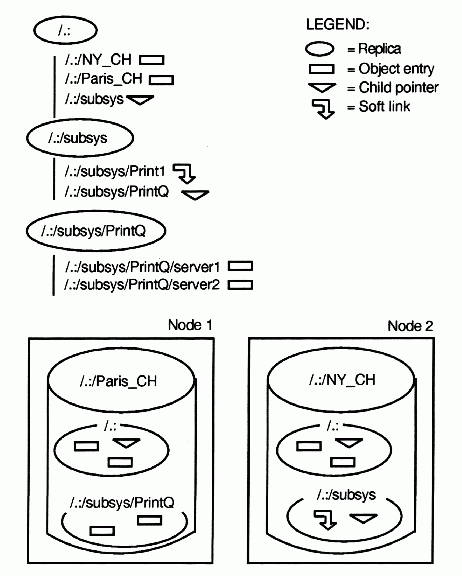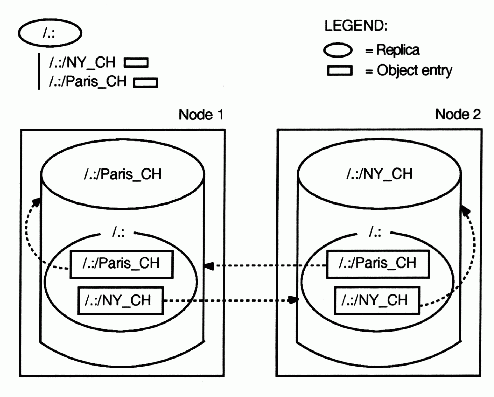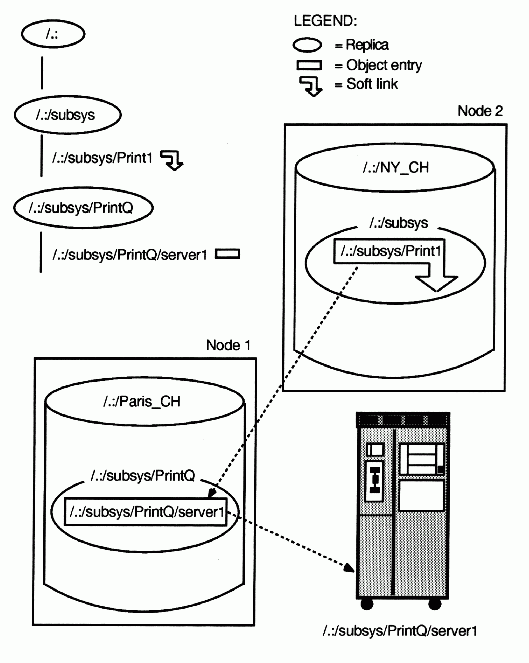Translating from Names to Resources
Just as directory names in a logical namespace hierarchy translate to physical replicas in clearinghouses, CDS names translate to physical resources that are used either internally by CDS or by client applications. The attributes of a name are what make the translation possible. This topic describes the relationship between CDS names and the physical resources that they describe.
The following figure shows three directories and their contents in a logical namespace, and how replicas of those directories are physically implemented in two clearinghouses. The clearinghouses themselves have CDS names: /.:/Paris_CH on Node 1 and /.:/NY_CH on Node 2. The _CH suffix is a recommended convention for naming clearinghouses. The /.:/Paris_CH clearinghouse contains replicas of the root directory and the /.:/subsys/PrintQ directory. The /.:/NY_CH clearinghouse contains replicas of the root directory and the /.:/subsys directory. Recommended practice is to create at least two replicas of every directory. Therefore, the /.:/subsys and /.:/subsys/PrintQ directories each need to be replicated in at least one other clearinghouse somewhere in the cell.
Logical and Physical Views of a Namespace

To discover the physical location of a resource, CDS looks up an attribute that is associated with its name. The following figures illustrate the connection between the various kinds of CDS names and the resources that they describe. The figures are based on the namespace in the figure above. All of the names in the following figures are in the same cell namespace, as evidenced by the use of the /.: prefix to represent the cell root. (See Managing Intercell Naming for information about name resolution across multiple cells.)
The figure entitled Clearinghouse Object Entries and Clearinghouses shows the relationship between two clearinghouse object entries and the clearinghouses that they describe. A clearinghouse object entry differs from other kinds of object entries in that it is created, used, and maintained by the CDS software instead of by a client application. However, it is like any other object entry in that it describes a physical resource in the network: the clearinghouse. CDS creates the object entry automatically when you create and name the clearinghouse.
The figure shows two clearinghouse object entries: /.:/Paris_CH, which points to the clearinghouse that is named /.:/Paris_CH on Node 1, and /.:/NY_CH, which points to the clearinghouse that is named /.:/NY_CH on Node 2. Each clearinghouse object entry has an attribute called CDS_CHLastAddress attribute, whose Tower subattribute contains RPC binding information that CDS uses to contact the node where the clearinghouse resides. (See Appendix B for a list of CDS attributes and their descriptions.)
Clearinghouse Object Entries and Clearinghouses

The figure entitled A Soft Link and Its Resolution shows the relationship between a soft link, the object entry it points to, and the resource that the object entry describes. The soft link, /.:/subsys/Print1, has an attribute called CDS_LinkTarget, which contains the name that the link points to: an object entry that is named /.:/subsys/PrintQ/server1. The object entry describes a print server machine that is used by an application called PrintQ. The replica containing the /.:/subsys/PrintQ/server1 object entry exists in the /.:/Paris_CH clearinghouse. The object entry has an attribute called CDS_CHLastAddress attribute, whose Tower subattribute contains RPC binding information that enables the PrintQ application to contact the print server machine.
A Soft Link and Its Resolution

The figure entitled Child Pointers and Directories shows the relationship between directories and their associated child pointers. It illustrates that, although a child pointer has the same name as its associated directory, the child pointer is a separate entry in the namespace and resides in the parent of the directory to which it refers.
In the case of hierarchical cells, the directory resides in the child cell and the child pointer, which has the same name as the associated directory and resides in the parent cell.
The root replicas in both clearinghouses contain a child pointer for the /.:/subsys directory. The /.:/subsys child pointer has an attribute called CDS_Replicas which contains the name and address of the /.:/NY_CH clearinghouse, where a replica of the /.:/subsys directory exists.
In the /.:/NY_CH clearinghouse, the replica of the /.:/subsys directory contains a child pointer for the /.:/subsys/PrintQ directory. The child pointer's XSCDS_Replicas attribute contains the name and address of the /.:/Paris_CH clearinghouse, where a replica of the /.:/subsys/PrintQ directory exists.
When a directory has multiple replicas, as is normally the case, the CDS_Replicas attribute lists all of the clearinghouses containing a replica of the directory. You can use the dcecp directory show command with the -replica and clearinghouse options to display this attribute.
Child Pointers and Directories
